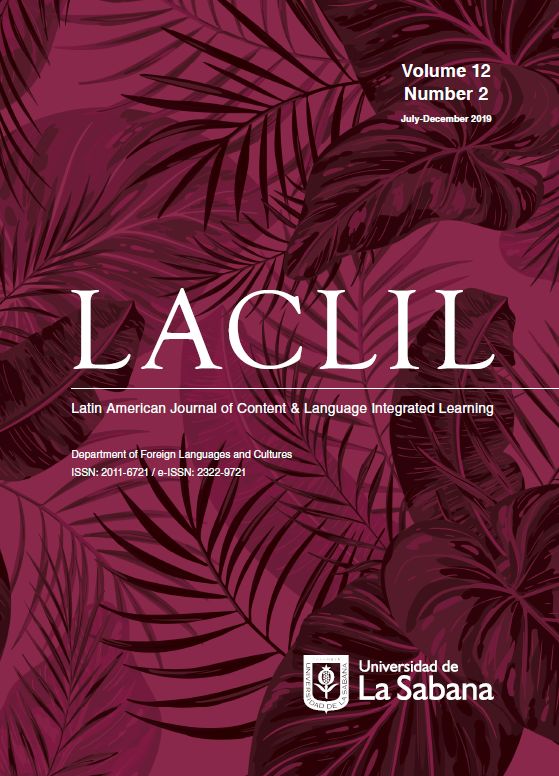What is next for CLIL Professional Development?
DOI:
https://doi.org/10.5294/laclil.2019.12.2.1Abstract
¿Qué sigue para el desarrollo profesional en AICLE?
O que vem agora para o desenvolvimento profissional em CLIL?
To reference this editorial (APA) / Para citar esta editorial (APA) / Para citar este editorial (APA)
McDougald, J. (2019). What is next for CLIL professional development? Latin American Journal of Content & Language Integrated Learning, 12(2), 197-206. https://doi.org/10.5294/laclil.2019.12.2.1
Downloads
References
Aiello, J., Di Martino, E., & Di Sabato, B. (2015). Preparing teachers in Italy for CLIL: Reflections on assessment, language proficiency and willingness to communicate. International Journal of Bilingual Education and Bilingualism, 0050(November), 1–15. http://dx.doi.org/10.1080/13670050.2015.1041873
Banegas, D. L. (2019). Teacher professional development in language-driven CLIL: A case study. Latin American Journal of Content & Language Integrated Learning, 12(2), 242-264. https://doi.org/10.5294/laclil.2019.12.2.3
Borko, H. (2007). Professional development and teacher learning: mapping the terrain. Educational Researcher, 33(8), 3–15. http://dx.doi.org/10.3102/0013189x033008003
Bruton, A. (2011). Are the differences between CLIL and non-CLIL groups in Andalusia due to CLIL? A reply to Lorenzo, Casal and Moore (2010). Applied Linguistics. http://dx.doi.org/10.1093/applin/amr007
Custodio, M. (2019). Influencing factors on in-service teachers’ competence in planning CLIL. Latin American Journal of Content & Language Integrated Learning, 12(2), 207-241. https://doi.org/10.5294/laclil.2019.12.2.2
Freeman, D., Reynolds, D., Toledo, W., & Abu-Tineh, A. M. H. (2016). Who provides professional development? A study of professional development in Qatar. Iranian Journal of Language Teaching Research, 4(3), 5–19.
Frigols-Martin, M. J. (2011). The European framework for CLIL teacher education. Language Teaching, 44(3), 401–402. http://dx.doi.org/10.1017/S0261444811000243
Murillo-Caicedo, A. J. (2016). Coaching for CLIL: A training proposal for non-CLIL content primary teachers in the Principado de Mónaco Bilingual School (Published Master’s thesis), Universidad Internacional de La Rioja.
Nikula, T., Dalton-Puffer, C., & García, A. L. (2013). CLIL classroom discourse: Research from Europe. Journal of Immersion and Content-Based Language Education. http://dx.doi.org/10.1075/jicb.1.1.04nik
Pérez-Cañado, M. L. (2016a). Are teachers ready for CLIL? Evidence from a European study. European Journal of Teacher Education, 39(2), 202–221. http://dx.doi.org/10.1080/02619768.2016.1138104
Pérez-Cañado, M. L. (2016b). Evaluating CLIL Programmes: Instrument design and validation. Pulso, 39, 79–112.
Reza, M. (2019). Feasibility of adopting English as a partial Medium of Instruction for mathematics and science subjects in Iranian senior high schools. Latin American Journal of Content & Language Integrated Learning, 12(2), 292-320. https://doi.org/10.5294/laclil.2019.12.2.5
Santana, J. del C. (2019). Establishing teacher-student rapport in an English medium instruction class. Latin American Journal of Content & Language Integrated Learning, 12(2), 265-291. https://doi.org/10.5294/laclil.2019.12.2.4
Tatzl, D. (2011). English-medium masters’ programmes at an Austrian university of applied sciences: Attitudes, experiences and challenges. Journal of English for Academic Purposes, 10(4), 252–270. http://dx.doi.org/10.1016/j.jeap.2011.08.003
Vázquez, V. P., & Ellison, M. (2013). Examining teacher roles and competences in (CLIL). Lingvarum Arena, 4(CLIL), 65–78.
Vilkancienė, L., & Rozgienė, I. (2017). CLIL Teacher competences and attitudes. Sustainable Multilingualism, 11(1), 196–218. http://dx.doi.org/10.1515/sm-2017-0019
Downloads
Published
How to Cite
Issue
Section
License
This Journal and its articles are published under the Creative Commons CC BY 4.0 DEED Attribution 4.0 International license. You are free to: Share — copy and redistribute the material in any medium or format for any purpose, even commercially. Adapt — remix, transform, and build upon the material for any purpose, even commercially. The license cannot revoke these freedoms as long as you follow the terms of the license.








